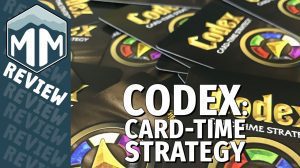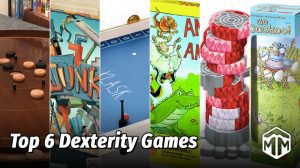Dragons have always been a staple within the world of gaming. Some may remember the first time they gave Dungeons and Dragons a try, while others will be more likely to reminisce over their encounters with legendary dragons in Skyrim. Still, in the midst of this cultural permeation, we often approach the story of a dragon from the hero/dragon slayer’s perspective. Rarely do we solely approach something from the dragon’s perspective. Luckily, there are a few gems out there that do just that.
Enter Dragoon.
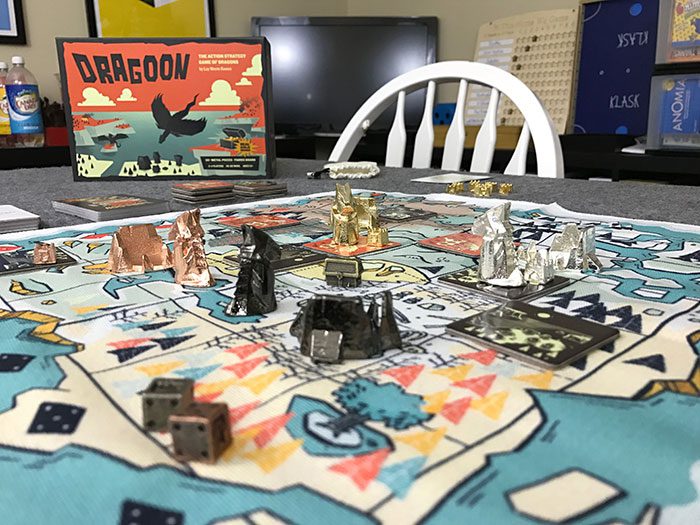
A review copy of Dragoon was provided at no cost from Lay Waste Games.
Overview
In Dragoon, 2-4 players take the role of a dragon who is bent on damage, destruction, and (of course) collecting gold. Each player will be taking turns venturing out across the board in hopes of claiming cities and villages that will slowly gain them gold, destroying cities and villages that will give them an immediate boost of gold, or seeking out the thief in order to reclaim stolen gold. The game plays out one round at a time (with each player taking one turn each round). In between rounds, players populate the board with new/upgraded cities and villages. This cycle continues until one player gains 50 gold to secure the victory.

Setting Up
Each player takes a set of player tokens of a single color. Depending on the number of players, they will each place their starting cave and dragon on a specific area of the map. Each player’s dragon skull token will be placed on the 0 mark on the scoring track alongside the thief’s skull token. Once the board is set up, each player is dealt three special action cards and the game begins!

The Population Phase
The first thing players will do each round is populate the board. One player will roll both dice (one representing the X axis and one representing the Y) a number of times equal to the number of players +1 and place a village tile in each rolled coordinate. If a village tile is already present, it is flipped into a city tile. If a city tile is already present or the coordinate is that of a dragon’s cave, no tile is placed and the thief token is moved up 3 spaces on the gold track.

The Action Phase
The second phase of each round is the Action Phase. In this phase each player takes a turn and is given three actions to help advance themselves forward. There are a total of eight actions that a player can take, which may seem overwhelming, but they are simple enough. Players can use actions to move around the board, destroy city/village tiles, gain control of tiles by placing totems, steal gold from other players or the thief, and draw cards. Additionally, players can play as many cards as they like, but that is more of a free action.

During the action phase, players will be trying to keep control of their current cities in addition to finding other ways to gain gold. Some will play more aggressively and fly around destroying cities and villages while others will try to be sneaky and steal gold from other players. Destroyed villages gain the player 2 points while destroyed cities gain 4. Players who choose to loot other player’s caves can roll a die and steal the amount of gold rolled. But they’ll lose 3 gold of their own and will be sent back to their cave if they do not escape their opponent’s cave by the end of the round. Players who take the sneaky approach and go after the thief will have the option of rolling a die to steal some gold directly from the thief. Additionally, players who enter the same space engage in combat by rolling a die to see who has the highest number. The losing player returns to their cave and loses three gold to the winning player.

The Tribute Phase
The final phase of the game is the Tribute Phase. During this phase, all players will have the opportunity to gain even more gold by rolling to see their loot. Any player with a dragon on a tile that they control will automatically score as if they rolled a 3, 4, or 5. All other controlled tiles will gain gold or possibly lose totems based on the roll of a die. Rolling a 1 means that the player must discard one of their totems from a tile. A 2 means that no gold is gained. Rolling a 3/4/5 means that the player will get 1 gold for a village and 3 gold for a city, while rolling a 6 will give 2 gold for a village and 4 for a city.
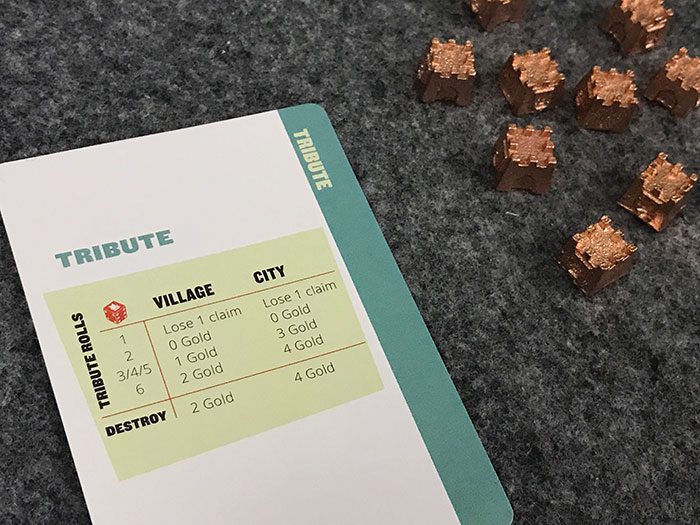
One of the largest ways to get points in the game is by building a large amount of totems across the board. With a large amount of tiles, a player can gain many points. One thing to note is that when a player ends with his dragon on another player’s tile, that tile does not score any points.
Thoughts
First off, the components in Dragoon are some of the best components of any game I’ve reviewed. All of the player pieces (and the dice!) are made of shiny metals. They are weighty and just feel great to plunk around the board. Oh, and the board is a beautiful, thick cloth that folds out on the table to reveal a colorfully illustrated board. All of the art across the rules, cards, and board really stands out with an attractive color scheme and eye catching visuals. Nick Nazzaro did a fantastic job with building the theme into the art. Seriously, this game is beautiful and is a looker. I was intrigued just from my first glance at it.
(note: we were given a copy of the deluxe edition with the metal pieces. I can not comment on the standard edition’s components, though the art is still the same.)
Still, a game is more than just its looks.
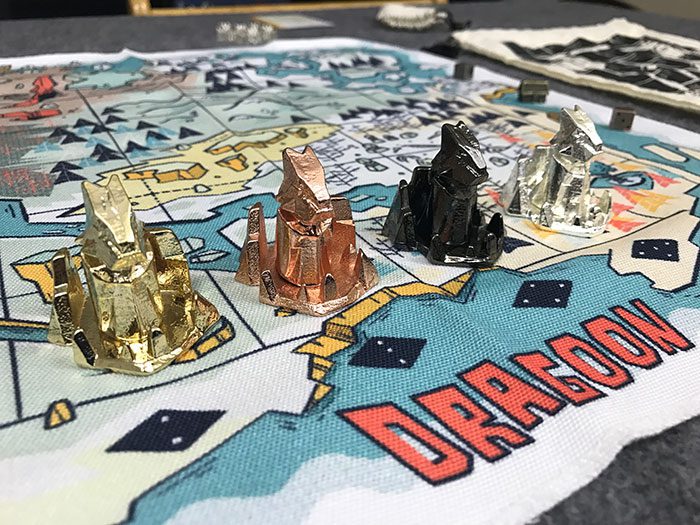
Dragoon is in a weird spot. It is targeted toward gamers, but includes a lot of randomness. Many gamers have become adverse to pure randomness created by dice in games. Before playing this one, I was quite worried that the combat, along with other things, would be completely ruined by the dice. Surprisingly, combat was such a rare thing that it really wasn’t a bother. The dice do randomly distribute tiles, though, which can sway the game in favor of the player closest to them. Honestly, this didn’t bother me too much since the players would self balance it for the most part by not letting a single player control too many plots.
Another point of randomness comes in with the special action cards. Each player gets to draw one card per turn, but can spend actions to draw extras. Overall, I thought the cards were pretty interesting and varied. They allowed you to do things like destroying adjacent tiles, moving extra spaces, and taking extra actions. Still, I can’t help but think that our game could have gone much differently depending on the cards each player drew.
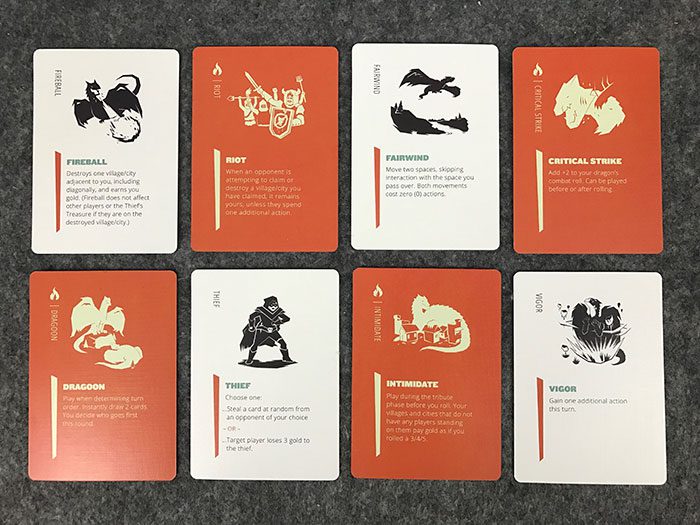
I guess the idea that randomness kills fun isn’t necessarily a hard and fast rule. Dragoon does have a lot of random attributes, but it is still reactive enough for players to be able to consider their actions and work around the randomness. The cards also add a little bit of risk mitigation by guaranteeing certain aspects that would normally be random. Ultimately, we still had fun with the game but I can see how it would be offputting for some players.
All things considered, there is just something special about stomping around a map as a dragon and destroying/claiming everything in sight. Dragoon isn’t perfect, but it is still fun. Would I recommend it to most hardcore gamers who are playing deep eurogames at their game nights? Probably not, but I think there is still a place for it. For new gamers, families, and younger players alike, Dragoon certainly tickles a special fancy with its enticing art and beautiful components and I think it could be a good fit for those players.
Be sure to check out Dragoon on Kickstarter right now!
What do you think about Dragoon? Give us your opinions about what you like and/or dislike about the game in the comments below!






